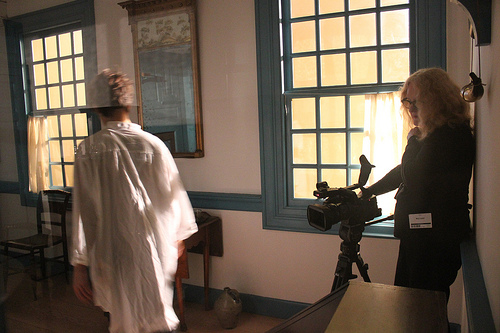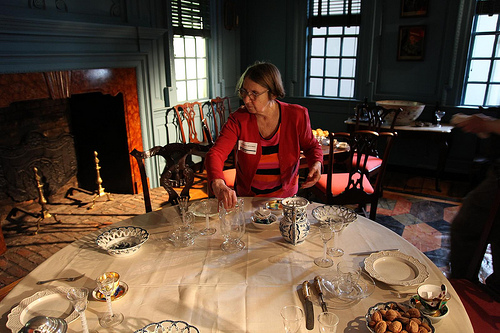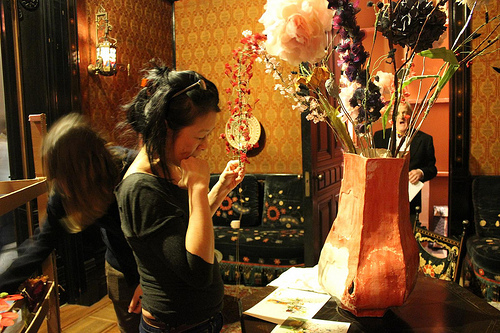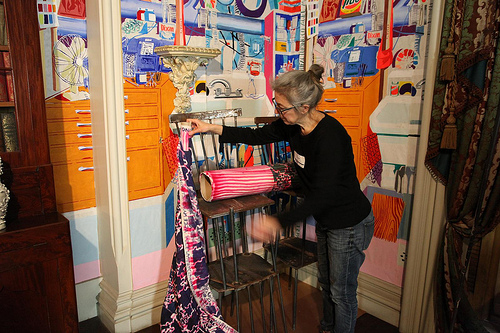Playing House: Working with Artists
In the exhibition Playing House four artists, Betty Woodman, Ann Chu, Ann Agee and Mary Lucier, install their own artwork into and around several period rooms on the 4th floor, activating the space to engage the viewer to think differently about the traditional presentation of domestic interiors. The museum has done these sorts of interventions before but on a smaller scale with Yinka Shonibare and Kiki Smith. This marks the first time that multiple artists are working together in concert.
As a conservator working with each of these artists, the sometimes conflicting working methods and points of perspective were a challenge to manage while remaining flexible. Conservators work within a set of principles, such as light is damaging too many artworks, handling should be kept to a minimum, and the interior environment can often be hazardous to the preservation of artifacts. Conservators need to have great hand skills, have an attention to detail, be creative problem solvers, and above all else, respect the object. Artists work within another set of principles. Everything is significant, details matter, experience must be illuminated, and all objects and materials can be put towards this purpose. Creativity is grand and ever changing and needs continuous feeding.
Do you see how there could be some conflict here?
Many of the period rooms were installed in the 1950’s and 60’s when museum best practices were much less formulated than they are today. The condition of the objects having been on continuous display since that time are often fragile and unknown as museum condition records were not what they are today. The first step in preparing for the installation was to get an overall plan from each artist as to what their intervention into the rooms would be. What did I say about creativity being grand and ever changing? The Curators did their best to wrangle broad concepts from the artists, and the Registrars compiled lists of the items coming and did their best to make sure that everything arrived safely and was accounted for.

Mary Lucier works with her team to film in the Dining Room of the Nicholas Schenck House.
The installation worked a bit differently for each artist. Mary Lucier with a video component needed access to the Schenck rooms well in advance of the other artists. The challenge was to prepare the rooms, and safeguard the collection while having actors, props, and the artist filming within the often cramped and tightly installed space. The plan of what to film was fluid and responsive to events as they happened. This meant that the conservator working with the artist needed to also be fluid and responsive to allow space for creativity while setting appropriate limits and boundaries.

Betty Woodman works with art handlers to install her ceramics in the Hall of the Cupola House.
Betty Woodman and Ann Chu proved challenging in that it was impossible to know which collection objects would work well with the artist’s objects until the artist arrived and began to arrange in each room; Cane Acres, Rockefeller, Russell, Cupola, Worgelt, and two dioramas. The difficulty was assessing on the spot whether a collection object could safely interact with the artist’s object. Is that vase too heavy for this piece of furniture? Is the ceramic cup stable on the period table?

Anne Chu works with art handlers to install her work in the Moorish Room of the John D. Rockefeller House.
Ann Agee’s was the most labor intensive installation. The artist made several pre-visits to the Milligan rooms as part of formulating what she wanted to transform the room into. Discussions about what was and was not impossible to remove from the room were fruitful. The compromises fed the creative process. With this installation, Ann much like a conservator had to be a creative problem solver too.

Ann Agee works with art handlers to install her work in the Library and Drawing Room of the Milligan House.
I think the experience in the end was fruitful for all and that the activations spark new illuminations on your experience.

Lisa Bruno is the head conservator of objects at the Brooklyn Museum, where she has been working since 1993. She has previously worked at the Art Institute of Chicago, and has had internships at The Cleveland Museum of Art, the Detroit Institute of Arts, and in private practice. She has a Masters Degree in Art Conservation from the University of Delaware, Winterthur Museum Art Conservation Department. She is a Professional Associate of the American Institute for Conservation.
